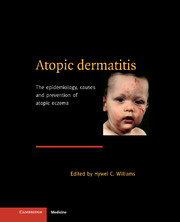Book contents
- Frontmatter
- Contents
- List of contributors
- Foreword Georg Rajka
- Preface
- Part I The nature of the problem
- Part II Descriptive studies which indicate the size of the problem
- Part III Analytical studies which point to causes of atopic dermatitis
- 8 Genetic epidemiology of atopic dermatitis
- 9 Fetal and perinatal origins of atopic dermatitis
- 10 Social factors and atopic dermatitis
- 11 The ‘old mother’ hypothesis
- 12 The possible role of environmental pollution in the development of atopic dermatitis
- 13 Atopic dermatitis in migrant populations
- 14 The role of inhalant allergens in atopic dermatitis
- 15 Dietary factors in established atopic dermatitis
- Part IV Intervention studies
- Part V Lessons from other fields of research
- Part VI Conclusions
- Additional information
- Index
- Plate section
15 - Dietary factors in established atopic dermatitis
from Part III - Analytical studies which point to causes of atopic dermatitis
Published online by Cambridge University Press: 17 August 2009
- Frontmatter
- Contents
- List of contributors
- Foreword Georg Rajka
- Preface
- Part I The nature of the problem
- Part II Descriptive studies which indicate the size of the problem
- Part III Analytical studies which point to causes of atopic dermatitis
- 8 Genetic epidemiology of atopic dermatitis
- 9 Fetal and perinatal origins of atopic dermatitis
- 10 Social factors and atopic dermatitis
- 11 The ‘old mother’ hypothesis
- 12 The possible role of environmental pollution in the development of atopic dermatitis
- 13 Atopic dermatitis in migrant populations
- 14 The role of inhalant allergens in atopic dermatitis
- 15 Dietary factors in established atopic dermatitis
- Part IV Intervention studies
- Part V Lessons from other fields of research
- Part VI Conclusions
- Additional information
- Index
- Plate section
Summary
Basic concepts
The first concept, the terra firma, is that in certain individuals, eating specific food triggers can cause preexisting atopic dermatitis (AD) to worsen. The second concept, which by no means follows from the first, is that avoidance of selected foods can cause AD to improve. This chapter tests the strength of the data that underpin these two assertions.
Food triggers can worsen preexisting atopic dermatitis
This concept is the result of two merged themes. The first is that some children with AD react adversely to certain foods. The second is that such reactions can cause worsening of preexisting dermatitis.
Some children with atopic dermatitis react adversely to foods
The key data come from Hugh Sampson and colleagues at Johns Hopkins Hospital in Baltimore, who used the double-blind placebo-controlled food challenge (DBPCFC) as a strategy to make the diagnosis of food allergy in children with AD. Despite great strengths, it is important to be aware of some inherent weaknesses in this study design.
In 1988, Sampson reported on 514 DBPCFCs in 160 selected patients with severe AD that was refractory to conventional therapy (Broadbent & Sampson, 1988; Sampson, 1988). The ages of the patients ranged from three months to 24 years, with a median age of 5.3 years; 96% of patients had a family history of atopic disease. At the time of study, 21% of patients had AD as their sole atopic disease, while the remainder also had asthma, rhinitis or both.
- Type
- Chapter
- Information
- Atopic DermatitisThe Epidemiology, Causes and Prevention of Atopic Eczema, pp. 193 - 202Publisher: Cambridge University PressPrint publication year: 2000
- 5
- Cited by



